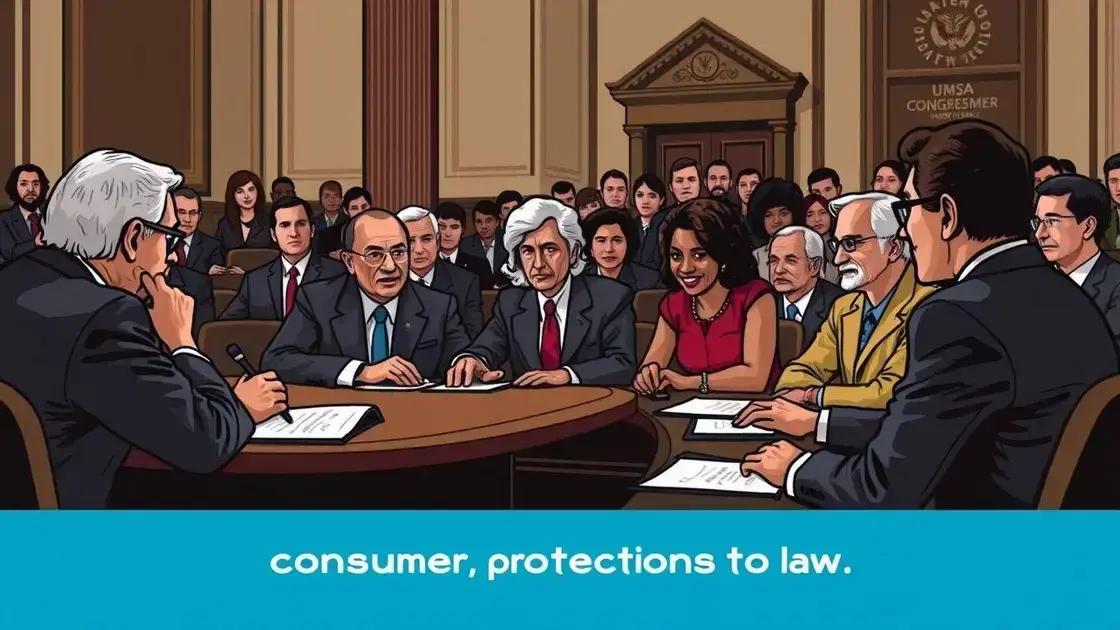Alarming reductions in federal consumer protection funding

Anúncios
Alarming reductions in federal consumer protection funding jeopardize consumer safety by limiting enforcement, cutting vital educational programs, and increasing risks for vulnerable populations, necessitating urgent advocacy for restoration and enhancement of these critical protections.
Alarming reductions in federal consumer protection funding are causing waves of concern among advocates and the general public alike. What does this mean for consumer rights? Let’s dive into the implications and potential outcomes.
Anúncios
Understanding federal consumer protection funding
Understanding federal consumer protection funding is essential for realizing how our consumer rights are safeguarded. This funding supports various programs aimed at protecting consumers from unfair practices and ensuring access to safe products.
What is Consumer Protection Funding?
Consumer protection funding comes from federal sources to help agencies enforce laws and regulations. These funds are allocated to different areas, including education, enforcement of regulations, and advocacy for consumer rights.
Anúncios
Sources of Funding
Major sources of federal funding include:
- Taxes used for government programs
- Fees collected from industries that must comply with consumer protection laws
- Grants aimed at specific projects in consumer safety
The combination of these sources is crucial for maintaining effective consumer protection initiatives. However, recent cuts have created challenges.
The Importance of Funding
Without adequate funding, agencies struggle to monitor compliance and enforce consumer protections. For instance, less money means fewer inspections of products and services, allowing unsafe items to reach consumers.
Additionally, consumer education programs rely on this funding to teach people their rights and how to recognize fraud. When these programs are undermined, consumers become more vulnerable to exploitative practices.
Current Trends
Recently, there have been alarming reductions in federal consumer protection funding. These cuts are concerning because they can lead to:
- Increased consumer vulnerability
- Less oversight of companies
- Fewer public awareness campaigns
Understanding these trends helps consumers recognize the importance of advocating for their rights and supporting funding initiatives. As the landscape changes, it’s crucial to stay informed about how funding affects consumer protection.
Current trends in funding reductions
Current trends in funding reductions for consumer protection are raising serious alarms. Over recent years, efforts to cut budgets have led to decreased resources for agencies that play vital roles in protecting consumers.
Recent Cuts in Funding
Government agencies responsible for consumer safety have reported significant budget cuts. These cuts are often justified by claims of needing to reduce overall spending. However, the impact on consumer protection is severe, leading to:
- Fewer resources for enforcement actions
- Reduced public awareness campaigns
- Decreased support for consumer education programs
This trend threatens the systems in place designed to keep consumers safe from harmful practices and unsafe products.
Impact on Consumer Rights
As funding decreases, the ability of agencies to act decisively diminishes. For instance, inspections of products have become less frequent, putting consumers at risk. With fewer regulations enforced, companies may not feel as compelled to adhere to safety standards.
Furthermore, the knowledge gap for consumers widens when educational programs are cut. Many individuals are unaware of their rights and how to advocate for themselves as a result.
Advocacy for Change
Consumer advocates and organizations are calling for increased funding to support essential programs. They argue that strong funding is necessary to protect consumer interests effectively. Keeping funding levels stable allows for:
- Stronger enforcement of existing laws
- Development of new consumer protection initiatives
- Increased public trust in consumer safety systems
Understanding these trends helps consumers recognize the need for advocacy, raising their voices to ensure proper funding for protection initiatives.
Impact of reduced funding on consumers

The impact of reduced funding on consumers is significant and concerning. As federal funding for consumer protection diminishes, many essential services and protections for consumers face threats. This decrease in financial support can lead to various negative consequences.
Increased Risk of Unsafe Products
With less funding, agencies responsible for ensuring the safety of products have fewer resources to conduct inspections. Consequently, unsafe products may not be identified and removed from the market in a timely manner. Consumers could unknowingly purchase items that pose health risks or fail to meet safety standards.
Limited Educational Resources
Educational programs designed to inform consumers about their rights often rely on federal funding. When budgets are cut, these programs may be significantly reduced or eliminated. As a result, consumers might not receive vitally important information. They may remain unaware of their rights and how to protect themselves from fraud.
- Less information on how to report unsafe products
- Reduced awareness of consumer rights
- Fewer workshops and resources available
This lack of knowledge can lead consumers to make poor choices when purchasing goods or services.
Effects on Vulnerable Populations
Reduced funding disproportionately affects vulnerable consumers, such as low-income families and the elderly. These groups often rely more heavily on consumer protection services. When funding declines, they may lose access to the assistance they need to navigate complex markets, leaving them at a heightened risk of exploitation.
Furthermore, with fewer protections in place, businesses may not feel compelled to adhere to ethical practices. This environment can create a less competitive marketplace that harms consumers.
Case studies of affected programs
Case studies of programs affected by funding reductions provide insight into how these cuts impact consumers and public safety. Numerous federal and state programs rely on adequate funding to operate effectively, and when budgets are slashed, the consequences can be dire.
Consumer Financial Protection Bureau (CFPB)
The CFPB, established to protect consumers in the financial sector, has faced funding challenges that limit its ability to enforce regulations. Without sufficient resources, the agency has struggled to monitor financial institutions for compliance. This reduction in oversight increases risks for consumers who may face unfair practices when securing loans or mortgages.
Nutrition Program for Women, Infants, and Children (WIC)
Another significant example is the WIC program, which provides nutrition assistance to vulnerable populations. Budget cuts have led to limited availability of services and lower outreach efforts. As a result, many eligible families do not receive the benefits they need for healthy development.
- Decreased access to healthy foods
- Reduced education on nutrition
- Less support for breastfeeding initiatives
This lack of support can have long-term effects on the health of mothers and children.
Environmental Protection Agency (EPA)
The EPA is also facing funding cuts that affect environmental protections. Programs responsible for monitoring air and water quality rely heavily on federal funding. When budgets are reduced, the enforcement of regulations weakens, potentially exposing communities to harmful pollutants. These cuts not only threaten public health but also diminish public trust in regulatory agencies.
Through these case studies, it’s clear how reduced funding for various programs can lead to significant negative impacts on consumer safety, health, and well-being. Understanding these examples is essential for advocating for the necessary funding to protect consumers.
Future outlook for consumer protection efforts
The future outlook for consumer protection efforts largely depends on the political landscape and public awareness of the importance of these programs. As funding issues persist, advocates are calling for renewed support to ensure robust protections for consumers.
Growing Awareness and Advocacy
In recent years, there has been a noticeable increase in consumer advocacy movements. These groups are working hard to raise awareness about the significance of maintaining strong consumer protections. As people become more educated about their rights, they are more likely to engage in advocacy efforts.
Legislative Changes
Potential legislative changes could also impact the future of consumer protection. Lawmakers may face pressure to prioritize funding for consumer protection agencies. Increased public support can result in new laws aimed at enhancing consumer rights, especially in sectors like finance, health care, and food safety.
- Stronger regulations on product safety
- Increased funding for consumer education programs
- Enhanced enforcement mechanisms for unfair practices
Such measures could help ensure that consumers are better protected in an increasingly complex marketplace.
The Role of Technology
Technology plays a significant role in shaping the future of consumer protection. Advances in data analysis and reporting can improve monitoring of businesses and help identify potential abuses swiftly. Technologies such as artificial intelligence can assist agencies in analyzing large datasets, leading to more effective enforcement actions against violators.
Overall, the future of consumer protection is intertwined with advancements in awareness, legislation, and technology. By advocating for better policies and utilizing new tools, stakeholders can work together to create a safer environment for all consumers.





